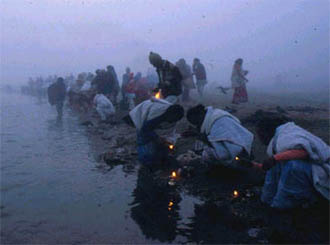May
the pot of prosperity boil over, |
 |
Makar
Sankrant, Nepal Photo courtesy the Brigade of Gurkhas (image subject to Crown copyright) |
Makar Sankrant, the first Hindu festival of the solar calendar year, is observed when the sun enters the zodiacal sign of Makar (Capricorn*). According to one account, the festival dates back to the origin of the earth, when gods and demons worked together to churn the nectar (amrit) of immortality. One drop of this amrit guaranteed immortality, and after this great feat was accomplished, the god Vishnu transformed himself into a woman to distract the demons, who understandably wanted the nectar for themselves. In the ensuring struggle, drops of amrit were spilled at four places corresponding to the cities of Allahabad, Nasik, Haridwar and Ujjain. Since then, bathing at these and other places has been considered a sacred rite and part of the observance of the festival.
In parts of the Punjab, the festival—which takes place during the rest period before the cutting and gathering of crops—is called Lohri. Huge bonfires are lit on the eve of the festival and friends and relatives gather to throw sweets, sugarcane and rice into the fire, declaring Aadar aye dilather jaye (“May honour come and poverty vanish!”)—a prayer to Agni, the fire god, to bless the land with abundance and prosperity.
In southern India the festival lasts for three days and is known as Pongal. On the first day, rice boiled with milk is offered to Indra, the god who bestows rain; on the second day, Surya is honoured. The festival is in honour of the harvest of rice, tumeric and sugarcane, and on the third day the family cattle are given a bath and dressed in gratitude for all their hard work in the fields.